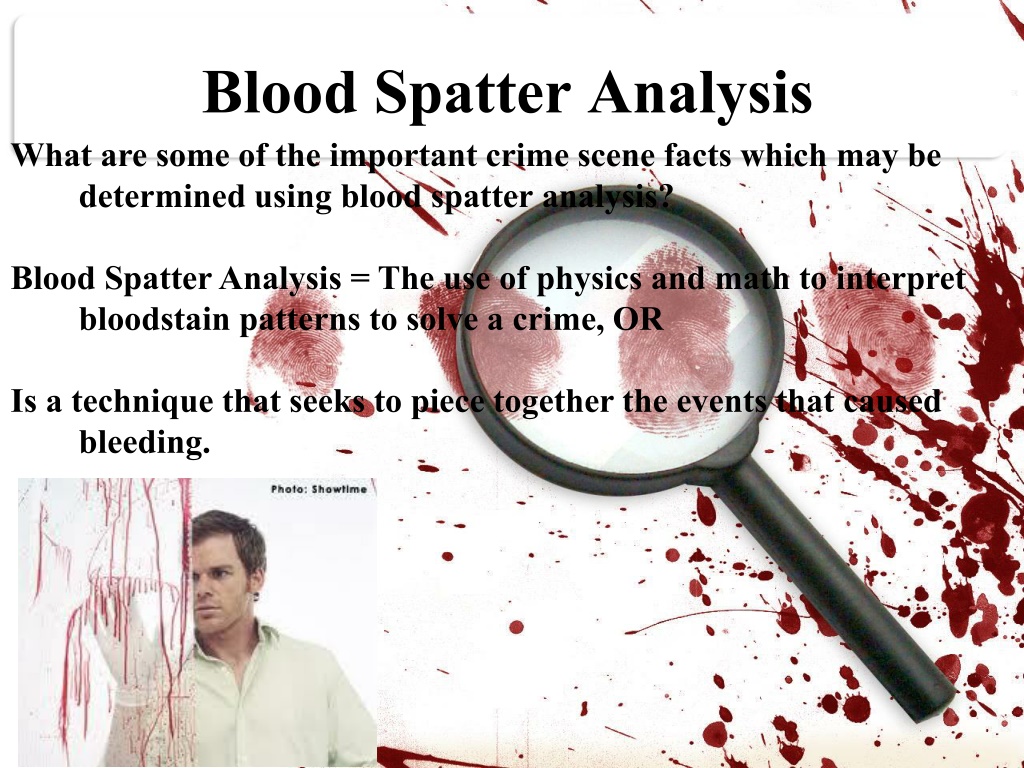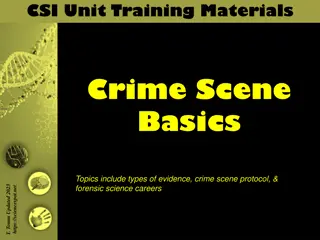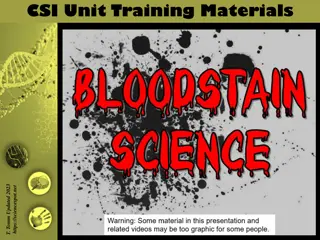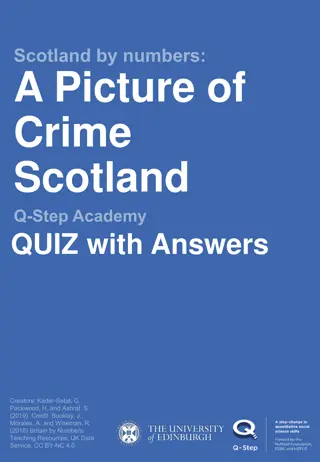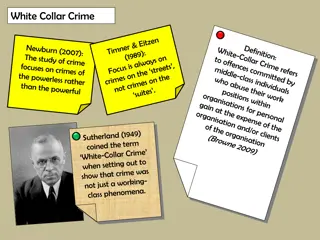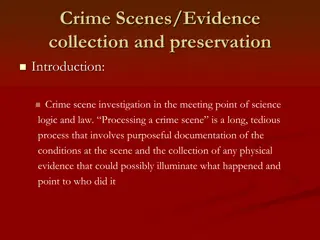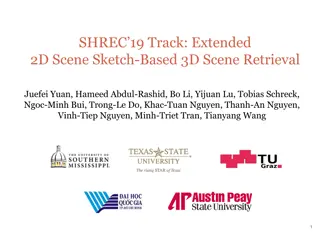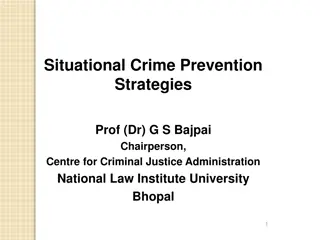Understanding Blood Spatter Analysis in Crime Scene Investigations
Blood spatter analysis is a crucial forensic technique that involves interpreting bloodstain patterns to uncover important crime scene facts such as the number of blows or shots, victim and object positioning, weapon characteristics, origin of blood spatter, movement of individuals or objects, impact type and direction, and more. This analysis serves as valuable circumstantial evidence in courtrooms, aiding in determining critical aspects of a crime. Renowned figures like Paul Kirk have significantly contributed to the development and application of bloodstain pattern analysis in criminal investigations.
Download Presentation

Please find below an Image/Link to download the presentation.
The content on the website is provided AS IS for your information and personal use only. It may not be sold, licensed, or shared on other websites without obtaining consent from the author. Download presentation by click this link. If you encounter any issues during the download, it is possible that the publisher has removed the file from their server.
E N D
Presentation Transcript
Blood Spatter Analysis What are some of the important crime scene facts which may be determined using blood spatter analysis? Blood Spatter Analysis = The use of physics and math to interpret bloodstain patterns to solve a crime, OR Is a technique that seeks to piece together the events that caused bleeding.
What are some of the important crime scene facts which may be determined using blood spatter analysis? The number of blows, shots, etc., causing the bloodshed and/or the dispersal of blood The position of the victim and/or object during bloodshed Movement of the victim and/or object after bloodshed What the weapon was like 5. The distance between the target surface and the origin of the blood 1. 2. 3. 4. 6. The point(s) of origin of the blood 7. Movement and direction of a person or an object 8. Type and direction of impact that produced the bloodshed
Bloodstain patterns are considered circumstantial evidence in a courtroom. Experts can argue many points, including direction of travel, height of the perpetrator, position of the victim, left/right hand, whether the body was moved, etc.
Paul Kirk (19021970) He was a professor of criminalistics and biochemistry at the University of California at Berkeley. He actively assisted law enforcement organizations from 1935 to 1967. His book Crime Investigation discussed the application of bloodstain pattern analysis to criminal investigations. Dr. Kirk analyzed the bloodstain pattern photos from the Sam Sheppard case and was instrumental in Sheppard s release after his second trial.
Bloodstain Terminology Angle of impact angle at which blood strikes a target surface Bloodstain transfer when a bloody object comes into contact with a surface and leaves a patterned blood image on the surface. The image is recognizable. Backspatter blood that is directed back toward the source of energy
Bloodstain Terminology, continued Cast-off blood that is thrown from an object in motion Point of Origin-Area of Convergence- three-dimensional view formed using lines of convergence and angles of impact of at least two different drops of blood to identify the source and location of blood spatter. Satellite Drop of Blood- Secondary drop formed when some blood breaks free from the main contact drop of blood
Bloodstain Terminology, continued Swipe wet blood is transferred to a surface that did not have blood on it Wipe a non-blood-bearing object moves through a wet bloodstain, altering the appearance of the original stain
Homework Find out more about the case at truTV s Crime Library. Write a one page summary on the Sheppard case, following rubric directions
What are some Basic Rules governing falling blood? A free falling drop of blood forms a sphere or ball. A blood droplet remains spherical in space until it collides with a surface. A spherical drop will break 1. When it hits another object 2. When acted upon by some force
What are some factors Affecting Shape of Blood Droplet? 1. Texture of the target surface Surface texture is one of the key components in determining spatter type. On clean glass or plastic droplet will have smooth outside edges On a rough surface will produce scalloping on the edges (spines) When a droplet hits the surface, which is hard as well as smooth, the blood actually breaks apart upon impact. This in turn creates smaller droplets (satellites). The smaller droplets will continue to move in the same direction as the original droplet
Several blood droplets that have fallen onto a rough surface.
2. HEIGHT: How will the shape and size change as the height is increased or decreased? as the angle remains the same. The size (diameter) of the drops Increases with increasing height. The number of satellites increases with increasing height. The shape does not change as long
3. VELOCITY: How does the velocity affect size and shape of blood drops? The smaller the size of spatter, the greater energy required to produce spatter 1. Low Velocity (Passive) Impact Bloodstains -Blood that falls at the speed or force of normal gravity These spatters usually fall from an open wound, or from a surface that is saturated with blood. The majority of the Low Force Impact Spatters are large, circular, spatters with diameters of 4mm or more. Low Force Impact Spatters will increase in size as the distance fallen increases. NOTE: It is important to note that the term "Velocity" does not measure the speed at which the blood is traveling, but rather is used to describe or measure amount of force applied to the blood, to cause it to spatter.
Passive bloodstains falling onto a smooth surface at approximately 90
Blood drips from injuries sustained during an International Fighting League match in New Jersey
2. Medium Velocity Bloodstains Medium Velocity Bloodstains - Produced with more energy or force than gravity (more than 25 feet/sec) The force of the impact causes the blood to break into smaller size spatters relative to the amount of force applied This type of spatter is usually seen in blunt force, stabbings, and secondary spatters Produced when the majority of larger drops of blood are broken into smaller spatters with diameters of 2 4 mm
Spatter deposited on a wall as a result of a blunt force beating.
3. High Velocity Bloodstains Impact spatter that measures less than 2mm in diameter The force necessary to produce this size spatter is greater than 100 ft per second This type of spatter is usually associated with gunshots, explosions, and high speed collisions High Force Impact Spatter takes on a "mist like" appearance
High-velocity spatter and blood drips after a suicide bombing in Dimona, Israel
Bloodstain Terminology, continued Directionality relates to the direction a drop of blood travels in space from its point of origin Terminal velocity the greatest speed to which a free-falling drop of blood can accelerate in air. It is dependent upon the acceleration of gravity and the friction of the air against the blood approximately 25.1 feet/second. High velocity greater than 25 feet per second, usually 100 feet per second; gives a fine mist appearance Medium velocity 5 to 25 feet per second Low velocity 5 feet per second or less
How do blood spatter experts determine the angle of impact and source of the blood? 1. Watch the YouTube video science of Murder: Blood Spatter http://www.schooltube.com/video/86fbaf533f b914fa37de/Science-of-Murder-Blood-Spatter 2. Answer the following from what you learned in the last few days and from watching the video: Why are safety precautions important when handing real human blood? What is stringing and how is it important in reconstructing a crime?
4. ANGLE OF IMPACT: How does impact angle affect the shape of a blood drop? The shape of the stain tends to change depending upon the angle of impact, which caused the stain. The steeper the impact, the more elliptical or elongated, the blood drop. Round if it falls straight down at a 90-degree angle Elliptical blood droplets elongate as the angle decreases from 90 to 0 degrees; the angle can be determined by the following formula: Width Length
Impact The more acute the angle of impact, the more elongated the stain. 90-degree angles are perfectly round drops. At about 30 degrees the stain will begin to produce a tail. Based on the diagram on the right, what was the impact angle for the drops below?
Angle of Impact Measure the length and width of the splatter. Divide the width of the splatter by its length. Determine the arcsin of that number, typically using a calculator with an arcsin function. Arcsin (opposite side/hypotenuse)
Angle of Impact Calculations The pointed end indicates the direction of travel of the drop prior to impact on a surface Measure the width and the length of stain/spatter width = 9mm Length = 18 mm 9 divided by 18 = 0.500 Arcsine 0.500 = 30 degree angle of impact ****Do not measure the tail
AIM: How do blood spatter analysts determine the source of the blood? Area of Convergence-OR-Point of Origin Do Now: Use the formula you learned in the previous lesson to calculate impact angle of a blood drop when Length = 25 mm Width = 15 mm Note: If you are not sure about the formula, or how to do it, check with your partner
Area of Intersection and Convergence The location of the blood source can be determined by drawing lines from the various blood droplets to the point where they intersect. The area of convergence is the point of origin the spot where the blow occurred. It may be established at the scene by measurement of angles with the use of strings.
Convergence Illustration of stain convergence on a three-dimensional plane. Convergence represents the point from which the stains originated.
How do Blood spatter analysts do it? www.youtube.com/watch?v=3jFKZaSeNjg After watching the short video answer the following: 1. Why do you think do they select certain blood drops? Do you see any advantages and disadvantages through the selection process?
How do blood spatter analysts categorize blood stains? Do Now: Use the formula you learned to find the angle of impact for the following drops: 1. The width is 9mm and the length is 18mm 2. The width is 1.5 cm and the length of the blood stain is 3.0cm 3. The width is 1.73cm and the length is 2cm
Answers to the DO NOW 1. sin-1(9mm/18mm) = 30 The angle of impact was 30 2. sin-1(1.5cm/3.0cm) = 30 The angle of impact was 30 3.sin-1(1.73cm/2cm) 59.99 (close to a 60 angle)
Categories of Blood Stains Passive Transer projected
Passive Bloodstains Passive bloodstains are drops created or formed by the force of gravity acting alone.
PASSIVE DROPS Dripped Blood Spilled Blood
Transfer Bloodstains A transfer bloodstain is created when a wet, bloody surface comes in contact with a secondary surface. A recognizable image of all or a portion of the original surface may be observed in the pattern, as in the case of a bloody hand or footwear.
Projected Bloodstains Projected bloodstains are created when an exposed blood source is subjected to an action or force, greater than the force of gravity. (Internally or Externally produced) The size, shape, and number of resulting stains will depend, primarily, on the amount of force utilized to strike the blood source.
Projected Bloodstains Arterial Spurt/Gush Bloodstain pattern(s) resulting from blood exiting the body under pressure from a breached artery Cast-off Stains Blood released or thrown from a blood-bearing object in motion Impact Spatter Blood stain patterns created when a blood source receives a blow or force resulting in the random dispersion of smaller drops of blood. Velocity affects stain pattern
AIM: How do we use the right triangle and the law of tangents to determine the heght of blood spatter? DO NOW: Describe how the following bloodstains were produced (i.e., low, medium, or high velocity spatter) . Please provide an explanation for your choices.
High Velocity Spatter High velocity spatter deals with gunshots, high speed collision, and explosions. The bloodstain pattern given off by high velocity spatter looks like a mist because of the high velocity. Let us note that when we say velocity we mean the measure of force that has been applied to the blood.
Medium Velocity Spatter Medium velocity spatter is given by blunt force and stabbings. When droplets are dispersed they break off into smaller droplets of blood. When dealing with a stabbing, such as in this case, the bloodstain pattern will be relatively linear.
Low Velocity Spatter 1.5m/s or less This spatter is formed after we have received our wound. For example, if I was to get cut in the arm and blood began to drip from the wound, I would then walk towards my first aid kit. The blood which hit the ground would have simply been dripping from my arm; there was no force applied to cause it to do anything else other than drip.
How do we determine drop height? Tangent of an angle = opposite/adjacent STEPS 1. use arc sign formula to determine angle 2. Use area of convergence to determine distance 3. Use tangent formula to determine height Origin of blood Height Angle of impact
1. Angle of Impact Blood spatter analysts measured the length and width of blood spatter and used the law of sins to determine the angle of impact. Angle of impact = arcsin (W/L) The angle of impact was determined to be 27 degrees
Area of Convergence Crime scene investigators used blood spatter on the floor of a crime scene to draw lines of convergence. The distance from the front edge of the drop to the area of convergence was 5.75 feet.
Point of Origin -or- Height Tangent of angle = opposite/adjacent = Height/distance Tangent of 27 degrees = (Height/5.75 feet) 0.575 = Height/5.75 feet 0.575 x 5.75 feet = Height Height = 3.3 feet 3.3 feet is the distance above the ground where the wound began bleeding Height? )27 Distance = 5.75 feet
Solve the following problems 1. Let us say that we find a blood stain 10ft. away from the source and we have determined that the angle of impact is 70 . Determine the height
Solution STEP 1: tan 70 = X/10 STEP 2: 10(tan 70 ) = 27.5ft. The height at which the blood fell was 27.5 ft.
